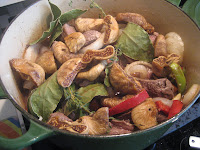Sometimes it takes a major event to shake you out of your lethargy and get your ass in gear to tackle those projects you keep procrastinating over. For me it was a second bout with breast cancer (no worries, I am fine now) and that compilation of recipes I kept meaning to assemble for my kids. No drama intended, but when you wonder if your days are numbered, you think about what you want to leave behind. For me, that meant my favorite recipes.
So, I did it. I gathered up all of my favorites, typed them into my computer, made up a table of contents, wrote an introduction and (voila!) Recipes From Home was produced. I even managed to compile an extensive index of which I am quite proud, particularly since it was done without the assistance of a computer (I couldn't figure out how) and laboriously created by hand, much of it accomplished on a very long flight to California.
Now in case you are thinking you can go to Amazon.com and order the thing, let me give you the bad news. You can't. Oh no, this is just about the most homespun book you will ever encounter, only slightly more professional that the stuff your six-year-old brings home from school. I print it out here at home and slide it into a looseleaf binder. It's as basic as you can get.
That said, it is a work of love and a gift from my heart. Initially it was intended only for Andy and Eric, however I quickly realized that it makes a great gift for those who mean the most to me. As I wrote in 2004, "if you have received a copy of this book, it really does mean that you are a part of our family." That still holds true today.
The genesis of Recipes From Home began on a boat in Crystal River, Florida. We were there with our dear friends, Stephen and Mark, for a weekend visit. Stephen decided we should do a sunset "cruise" so we loaded up the boat with wine and cheese and hit the river. In the middle of the solitude on the water, my cell phone rang. It was Andy. "Hey Mom, how do I roast brussels sprouts?"
Hence, the book. You may not be able to obtain a copy of it, but I am happy to share some recipes with you on this blog. Here is one of my favorites.
1 cup granulated sugar
1 cup spring water
2 cups freshly squeezed lime juice
1 quart good vodka
Combine sugar and water in a saucepan over high heat. Bring to a boil, then reduce heat and simmer for 3 minutes, stirring occasionally until sugar is completely dissolved. Remove heat and let cool slightly.
In a large bowl or container, combine sugar mixture, lime juice and vodka. Stir well, then pour into a container large enough to hold the mixture with room for expansion. Freeze.
Yield: a little more than 1 quart (or enough to make a lot of people quite tipsy) Go Henry.
Due to the alcohol content, it will not freeze completely. When ready to imbibe, pour into shot glasses and shout "NASTROVIA!" then either chug it or sip it slowly. Either way works. Just don't imbibe too much of the stuff or you will seriously regret it the next day!


























